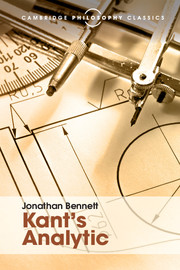4 - The inner-sense theory
from Aesthetic
Published online by Cambridge University Press: 05 July 2016
Summary
The form of inner sense
Kant says that time is the form of inner sense, as space is the form of outer sense: all experienced things outside oneself must be spatially ordered, and all experience whatsoever must be temporally ordered.
Here is an analogue. A submarine captain wears sun-glasses all the time and sees beyond his submarine only through a slightly defective periscope: everything he sees looks green, and everything he sees outside his vessel looks blurred as well. This analogue, like the piano one in §5, is inadequate and dangerous. Still, it illustrates Kant's view of the formal relationship between inner and outer sense; and its very defects serve to remind us that Kant, in offering his doctrine of inner sense as synthetic, may have to construe inner sense as a noumenal mechanism which stamps temporality upon its products.
A preliminary point:– I have not spoken of outer experience as itself being spatial or Euclidean, because I do not think that spatial terms can be applied in their ordinary meanings to experience, i.e. to sensory states or sense-data. Those who think that spatial concepts are rooted in visual considerations, and who treat visual sense-data as though they were thin coloured pictures, will cheerfully apply spatial terms to visual sense-data: ‘The green patch is to the left of the red patch and a little larger than it.’ Wishing to avoid this kind of talk, I have spoken of outer experience not as Euclidean but as Euclid-confirming, or as of something Euclidean—or, in the weaker version, of something spatial. The situation changes, however, when we come to the inner-sense theory. It is not satisfactory to express Kant's thesis in the form ‘All inner experience must be of something which is temporal’, for some inner experience is not in any plain sense ‘of’ anything at all. (I here reject Kant's unhappy notion that, just as outer experience is one's encounter with an objective realm, inner experience is one's encounter with oneself.) But we can speak of experience as being itself temporal in a way in which we cannot speak of it as being itself spatial.
- Type
- Chapter
- Information
- Kant's Analytic , pp. 47 - 63Publisher: Cambridge University PressPrint publication year: 2016



